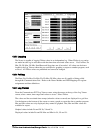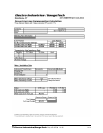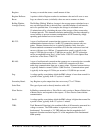
e Electro Industries/Gauge Tech Doc # E107706 V1.25 Glossary-4
Modbus ASCII: Alternate version of the Modbus protocol that utilizes a different data transfer
format. This version is not dependent upon strict timing, as is the RTU version.
This is the best choice for telecommunications applications (via modems).
Modbus RTU: The most common form of Modbus protocol. Modbus RTU is an open protocol
spoken by many field devices to enable devices from multiple vendors to
communicate in a common language. Data is transmitted in a timed binary
format, providing increased throughput and therefore, increased performance.
Network: A communications connection between two or more devices to enable those
devices to send and receive data to one another. In most applications, the
network will be either a serial type or a LAN type.
NVRAM: Nonvolatile Random Access Memory is able to keep the stored values in
memory even during the loss of circuit or control power. High speed NVRAM
is used in the Nexus to gather measured information and to insure that no
information is lost.
Optical Port: A port that facilitates infrared communication with a (1260/1270) meter. Using
an ANSI C12.13 Type II magnetic optical communications coupler and an
RS-232 cable from the coupler to a PC, the meter can be programmed with
Nexus Communicator software.
Packet: A short fixed-length section of data that is transmitted as a unit. Example: a
serial string of 8-bit bytes.
Percent (%) THD: Percent Total Harmonic Distortion. (See THD.)
Protocol: A language that will be spoken between two or more devices connected on a
network.
PT Ratio: Potential Transformer Ratio used to scale the value of the voltage to the primary
side of an instrument transformer. Also referred to as VT Ratio.
Pulse: The closing and opening of the circuit of a two-wire pulse system or the
alternate closing and opening of one side and then the other of a three-wire
system (which is equal to two pulses).
Quadrant: Watt and VAR flow is typically represented usng an X-Y coordinate system.
(Programmable The four corners of the X-Y plane are referred to as quadrants. Most power
Values and Factors applications label the right hand corner as the first quadrant and number the
on the Nexus) remaining quadrants in a counter-clockwise rotation. Following are the
positions of the quadrants: 1st - upper right, 2nd - upper left, 3rd - lower left
and 4th - lower right. Power flow is generally positive in quadrants 1 and 4.
VAR flow is positive in quadrants 1 and 2. The most common load conditions
are: Quadrant 1 - power flow positive, VAR flow positive, inductive load,
lagging or positive power factor; Quadrant 2 - power flow negative, VAR flow
positive, capacitive load, leading or negative power factor.


















